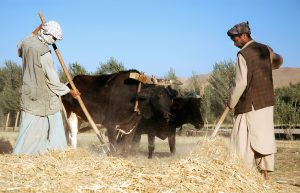While the Taliban’s interim government continues to tout progress on the regime’s sustainability goals, 15.3 million people in Afghanistan are facing acute food insecurity, with an additional 2.8 million in a state of emergency food insecurity. The Afghan government has sought to change the dynamic with potential donors and partners, enforcing a ban on poppy and cannabis cultivation while using the national press to underscore new agricultural deals and progress.
In July, the Afghanistan Ministry of Agriculture, Irrigation, and Livestock announced a five-year plan to replace poppy and cannabis with other crops. The regime has used the prohibition to change the narrative with the international community regarding aid. Afghanistan sorely needs assistance. Yet the Taliban have a narrow window to demonstrate progress before internal pressures to loosen the drug cultivation ban become overwhelming.
To compensate for the loss of poppy and hashish revenue for farmers, the government has improved access for agricultural exports in Central Asia and to a lesser extent China and India. This has furthered the Taliban’s strategy to build access and commercial ties to its neighbors and regional powers.
However, the natural challenges to the Taliban’s plans are daunting. Pests and severe weather continue to damage crops and limit yields in several areas. High winds have compounded the lack of water in the few arable areas of Nimruz Province. Locusts damaged crops across northern Afghanistan and untimely rains in Kandahar limited the grape harvest. The country has faced drought over the last three years. Persistent conflict in Afghanistan has demonstrably eroded traditional knowledge and support of native resource-efficient and low-cost water systems, like karez irrigation systems.
While the government has sought to improve irrigation across the country, the majority of the work remains incomplete. Further, Afghanistan’s neighbors have protested the Qosh Tepa Canal and dams along Afghanistan’s international river systems. The Taliban seeks to utilize water from these transborder rivers to bolster Afghanistan’s crops and then sell them internationally, but its neighbors worry about the impact on their own water security.
Taliban plans for self-sufficiency and the expansion of agricultural exports seem unachievable given the overwhelming lack of support infrastructure and the current, slow rate of investment.
A large majority of the Afghan population works in the agriculture sector, mostly growing crops to meet their families’ needs. These farmers sell their surpluses immediately after harvest, resulting in a local glut of crops that fetch lower prices. Food storage capacity is low in Afghanistan, and those who have enough to save surplus crops for later tend to lose excessive amounts of food to rotting and pests. Further, Afghanistan’s underdeveloped transportation system limits the ability of most growers to bring their crops to domestic markets, let alone international buyers.
Instead of cultivating poppy and hashish, most Afghan farmers planted wheat this year to feed their families. The Ministry of Agriculture, Irrigation, and Livestock estimated that 5 million metric tons of wheat were harvested this year – far short of the 7 million tons the government calculates necessary to achieve self-sufficiency.
The Taliban government is intent on facing these challenges on its terms. Afghanistan’s agricultural policy and drug bans, like most of the interim government’s efforts, are best seen through the lens of social control. The Taliban’s drug ban prevents local officials and tribal leaders from maintaining cash flows and international connections outside of the regime’s control. Further, it alters the international community’s interactions with the government, removing a key international talking point and minimizing accusations of a drug trade-funded emirate. Long suspicious of international aid, the Taliban’s drive for crop diversification, international trade access, and self-sufficiency will continue to mitigate the international community’s already limited ability to pressure the regime.
Currently, the government is doing just enough to keep things going. Food prices appear to be stable. The Ministry of Agriculture, Irrigation, and Livestock reportedly completed 271 projects and delivered seeds, fertilizers, and storage facilities for harvested crops over the last year. The ministry also provided nearly $19 million to farmers and livestock owners through the Agricultural Development Fund. Long the center of Afghanistan’s poppy cultivation, Helmand Province instead produced nearly 2,600 metric tons of basil this year. Kunduz also saw an increase in rice production.
The government has started rudimentary, grass-roots actions to mitigate climate change-worsened flooding risks while preserving forests and agricultural land. Further, the regime has not targeted the local reserves of opium that many farmers and traffickers have in storage, limiting the immediate impact of the narcotics ban.
While some claim the dismal state of Afghanistan’s economy will doom the poppy ban, the Taliban appear to be operating under a different view. If the emirate can withstand the pressures of climate change and the temptations of drug revenue, improving its agricultural prospects would set a foundation for the extremely conservative Islamic government that the Taliban seek to build. It seems unlikely Afghanistan will ever achieve agricultural self-sufficiency, but the regime could hold on if it makes demonstrable progress. With so much of the Afghan population involved in agriculture, the next few harvests could prove decisive for the success of the Taliban’s policies.
Afghanistan’s agricultural plans are a critical part of the Taliban’s efforts to win the support of regional powers, diversify its revenue streams, expand domestic control, and improve livelihoods across the country.
































